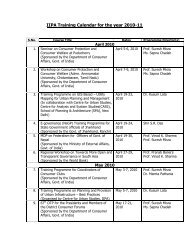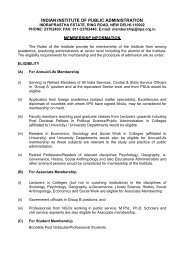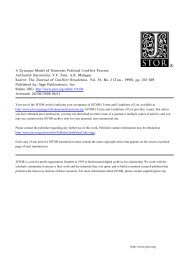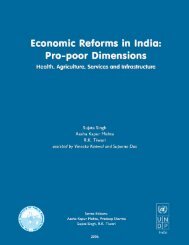Privatisation of Health Care in India - Indian Institute of Public ...
Privatisation of Health Care in India - Indian Institute of Public ...
Privatisation of Health Care in India - Indian Institute of Public ...
- No tags were found...
You also want an ePaper? Increase the reach of your titles
YUMPU automatically turns print PDFs into web optimized ePapers that Google loves.
3Private <strong>Health</strong> Services <strong>in</strong> <strong>India</strong>:An OverviewviewThe follow<strong>in</strong>g section traces the evolution <strong>of</strong> the privatesector and explores its characteristics for <strong>India</strong> and the specificstates under study. It is well known that <strong>India</strong>’s privatesector <strong>in</strong> health care is characterised by plurality <strong>in</strong> terms<strong>of</strong> systems <strong>of</strong> medic<strong>in</strong>e and the forms <strong>of</strong> practice. Evenbefore Independence, the s<strong>in</strong>gle largest category <strong>of</strong> providersconsisted <strong>of</strong> private practitioners across allopathic,ayurveda, unani, siddha and homeopathy (Baru, 1993). Individualpractitioners dom<strong>in</strong>ate the private sector <strong>in</strong> all thesesystems but from the seventies the growth <strong>of</strong> nurs<strong>in</strong>ghomes and hospitals was largely conf<strong>in</strong>ed to the allopathicsystem <strong>of</strong> medic<strong>in</strong>e. Other <strong>in</strong>digenous systems <strong>of</strong> medic<strong>in</strong>edid not witness a similar k<strong>in</strong>d <strong>of</strong> growth at the secondaryand tertiary levels <strong>of</strong> health care. Clearly the growth<strong>of</strong> the private secondary and tertiary levels <strong>of</strong> care wereconf<strong>in</strong>ed largely to urban areas and rural areas where therewas agrarian prosperity. The relationship between economicdevelopment and the growth <strong>of</strong> private services is obviousand this has been empirically shown <strong>in</strong> a study compar<strong>in</strong>gthe poorer and richer districts <strong>in</strong> Andhra Pradesh(Baru, 1993). This study showed that the number <strong>of</strong> private<strong>in</strong>stitutions at the secondary level <strong>of</strong> care was skewed<strong>in</strong> favour <strong>of</strong> the developed districts as compared to thepoorer ones. This trend has been observed across states,supported by the data on the growth <strong>of</strong> private <strong>in</strong>stitutionsfrom the mid 1980s. The better developed states haveseen a growth <strong>of</strong> private <strong>in</strong>stitutions at the secondary andtertiary levels (Table 1).The three states under study represent vary<strong>in</strong>g levels <strong>of</strong>development, private medical care and public health services.Maharashtra represents a developed state, Karnataka,a middle level and Orissa a poorly developed state. Giventhese variations, one would like to exam<strong>in</strong>e the growth <strong>of</strong>the public and private sectors <strong>in</strong> these states. Given thepaucity <strong>of</strong> data on the private sector, we are rely<strong>in</strong>g onpublished sources to discern the broad trends for the secondaryand tertiary levels <strong>of</strong> care. The data on primarylevel care is not available, but we have made use <strong>of</strong> publishedand unpublished studies that give us some <strong>in</strong>sight<strong>in</strong>to the numbers and characteristics <strong>of</strong> the providers <strong>in</strong>the private sector at this level. Utilisation <strong>of</strong> services forboth outpatient and <strong>in</strong>patient care is exam<strong>in</strong>ed <strong>in</strong> the context<strong>of</strong> the structures <strong>of</strong> provision<strong>in</strong>g. This analysis willstudy the variations across selected states, across <strong>in</strong>comegroups and also the vulnerable social groups, namely, thescheduled castes and scheduled tribes. S<strong>in</strong>ce NSS (NationalSample Survey) data is available for the mid-eighties andthe n<strong>in</strong>eties, it is possible to study if there has been any shift<strong>in</strong> utilisation patterns. All these three states have opted forreform<strong>in</strong>g health systems as a part <strong>of</strong> the World Bank f<strong>in</strong>ancedproject, which is part <strong>of</strong> the ‘s<strong>of</strong>t loans’ that severalstates have opted for.If one exam<strong>in</strong>es the trends <strong>in</strong> crude death and <strong>in</strong>fant mortalityrates (IMR) for these three states one f<strong>in</strong>ds that thelatter reflects the level <strong>of</strong> development. In 1995,Maharashtra had an <strong>in</strong>fant mortality rate <strong>of</strong> 55 per 10005

















